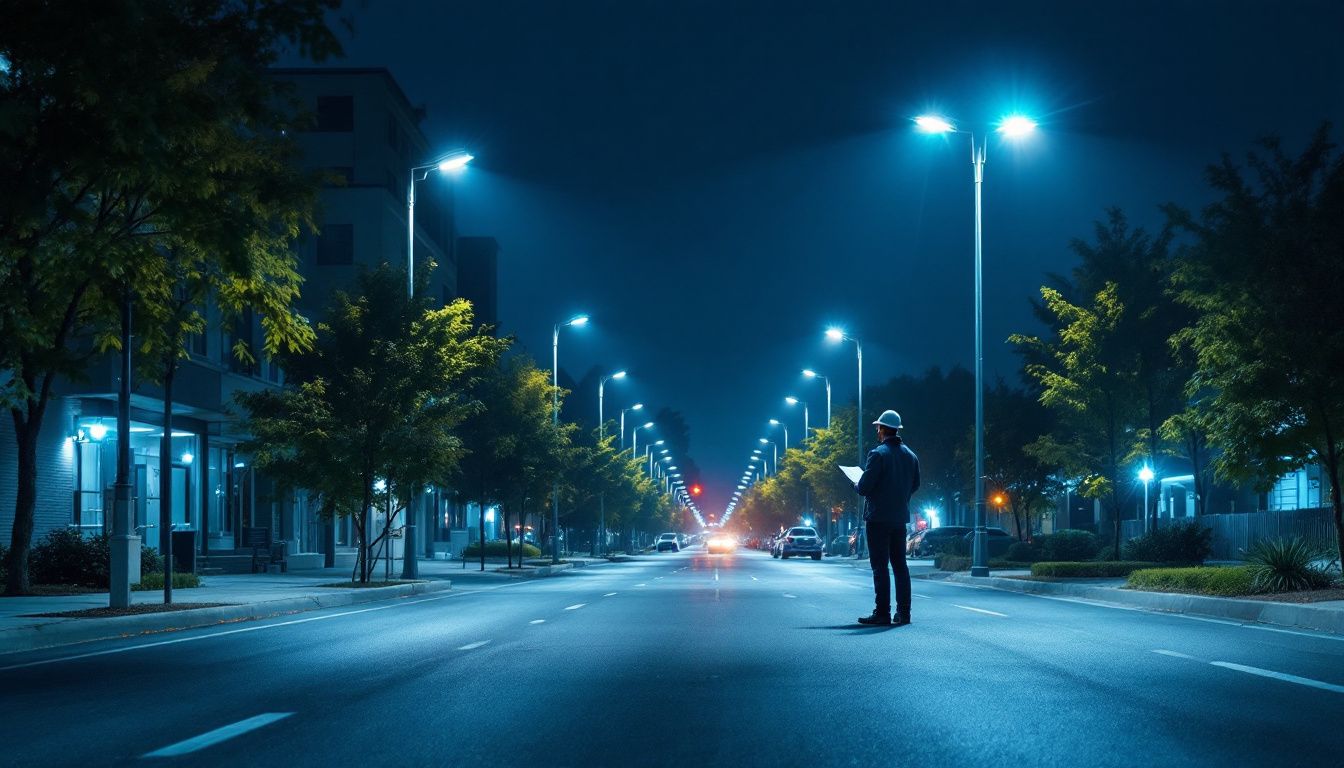
In the ever-evolving world of lighting design and installation, understanding the nuances of different lighting types is crucial for contractors. One such type that has gained significant attention is the Type S light. This article delves into the essential aspects of Type S lights, providing insights and information that every lighting contractor should be familiar with.
Type S light refers to a specific category of lighting that is characterized by its unique features and applications. Generally, Type S lights are designed for specialized environments where precision and efficiency are paramount. These lights are often used in settings such as commercial spaces, industrial facilities, and even residential applications where specific lighting requirements must be met.
One of the defining characteristics of Type S lights is their ability to deliver high-quality illumination while minimizing energy consumption. This makes them an attractive option for contractors looking to provide sustainable lighting solutions. Additionally, Type S lights often feature advanced technology that allows for better control over brightness and color temperature, ensuring that the lighting can be tailored to the needs of the space.
Another important aspect is their durability. Type S lights are typically built to withstand harsh conditions, making them suitable for both indoor and outdoor applications. This resilience is crucial for contractors who need to ensure that their installations will last and perform optimally over time. Moreover, many Type S lights are designed with weather-resistant materials, which not only prolongs their lifespan but also reduces maintenance costs, making them a smart investment for any project.
Type S lights can be found in various applications, each benefiting from their unique features. In commercial settings, for instance, these lights are often used in retail spaces to enhance product visibility and create an inviting atmosphere. The ability to adjust the color temperature allows for a dynamic environment that can change according to the time of day or specific events. For example, warmer tones can be employed during evening hours to create a cozy ambiance, while cooler tones can be utilized during the day to promote alertness and energy among shoppers.
In industrial environments, Type S lights are invaluable for ensuring safety and productivity. Their bright, focused illumination helps workers perform tasks with precision, reducing the risk of accidents. Furthermore, these lights can be integrated with smart technology, allowing for remote control and monitoring, which is an attractive feature for modern facilities. This integration not only enhances operational efficiency but also provides valuable data analytics, enabling facility managers to optimize lighting schedules based on occupancy and usage patterns, ultimately leading to further energy savings and improved workplace conditions.
For lighting contractors, understanding the benefits of Type S lights can significantly enhance their offerings. These lights not only provide energy efficiency but also contribute to a more sustainable approach to lighting design. By choosing Type S lights, contractors can help clients reduce their energy bills while also minimizing their carbon footprint.
One of the most compelling benefits of Type S lights is their energy efficiency. These lights often utilize LED technology, which consumes significantly less power compared to traditional lighting options. This reduced energy consumption translates to lower utility costs for clients, making Type S lights a financially attractive choice.
Moreover, many Type S lights come with features such as dimming capabilities and motion sensors, further enhancing their energy-saving potential. By incorporating these technologies, contractors can provide solutions that not only meet but exceed client expectations regarding energy efficiency. Additionally, the longevity of LED lights means that replacements are less frequent, reducing waste and contributing to a more sustainable environment. This durability is particularly appealing to clients looking for long-term solutions that align with eco-friendly practices.
Another advantage of Type S lights is their superior lighting quality. These lights are designed to produce a consistent and high-quality illumination that enhances the overall aesthetic of a space. The ability to adjust color temperatures allows for greater flexibility in creating the desired ambiance, whether it’s a warm, inviting glow for a restaurant or a bright, focused light for a workshop.
Furthermore, Type S lights often have a high Color Rendering Index (CRI), which means they accurately represent colors. This is particularly important in settings such as galleries or retail stores, where color fidelity can significantly impact customer experience and satisfaction. The ability to showcase products or artwork in their true colors can lead to increased sales and a more engaging environment for patrons. Additionally, the uniform distribution of light helps to eliminate harsh shadows and glares, creating a more comfortable and visually appealing atmosphere for both employees and customers alike. This attention to lighting quality not only enhances the functionality of a space but also elevates the overall design aesthetic, making Type S lights an indispensable choice for modern lighting solutions.
When it comes to installing Type S lights, there are several key considerations that contractors must keep in mind. Proper installation is crucial to ensure optimal performance and longevity of the lighting system.
Before installation, it is essential to thoroughly assess the space where the Type S lights will be used. Factors such as ceiling height, room dimensions, and existing electrical infrastructure play a significant role in determining the appropriate type and number of lights needed. A well-planned installation will not only enhance the functionality of the lighting but also contribute to the overall design of the space.
Additionally, considering the specific needs of the occupants is vital. For example, in a workspace, the lighting should be bright enough to reduce eye strain while also being adjustable to accommodate different tasks. Understanding these requirements will help contractors make informed decisions during the installation process. Moreover, the color temperature of the lights can significantly influence mood and productivity; cooler tones often promote alertness, while warmer tones can create a more relaxed atmosphere. Therefore, it is beneficial to engage with the end users to gather insights on their preferences and needs, ensuring that the lighting solution is tailored to enhance their experience.
Another critical aspect of installing Type S lights is ensuring compliance with local regulations and standards. Lighting contractors must be familiar with the relevant codes that govern electrical installations, as well as any specific requirements for energy efficiency. Failure to comply with these regulations can result in costly fines and may jeopardize the safety of the installation.
Staying updated on industry standards is essential for contractors. Regular training and professional development can help ensure that contractors are aware of the latest regulations and technologies, enabling them to provide the best service to their clients. Additionally, understanding the environmental impact of lighting choices is becoming increasingly important. Many regions are adopting stricter energy efficiency standards, and using LED Type S lights can not only meet these requirements but also significantly reduce energy consumption over time. By prioritizing sustainable practices, contractors can position themselves as leaders in the industry, appealing to environmentally conscious clients and contributing to a greener future.
To maximize the lifespan and performance of Type S lights, regular maintenance is essential. Proper care not only ensures that the lights function optimally but also helps prevent costly repairs or replacements down the line.
Conducting routine inspections is a crucial part of maintaining Type S lights. This involves checking for any signs of wear and tear, such as flickering or dimming lights, which may indicate a need for replacement or repair. Regular inspections also provide an opportunity to clean fixtures and bulbs, as dust and grime can significantly impact light output.
Contractors should encourage clients to establish a maintenance schedule that includes these inspections. By being proactive, clients can avoid unexpected issues and ensure that their lighting systems remain efficient and effective over time. Additionally, documenting the findings from each inspection can help track the performance trends of the lighting system, allowing for more informed decisions regarding maintenance and upgrades. This practice not only enhances the reliability of the lighting but also serves as a valuable reference for future maintenance needs.
As technology continues to advance, upgrading Type S lights may become necessary to keep up with the latest innovations. Newer models may offer improved energy efficiency, enhanced features, or better performance. Contractors should stay informed about advancements in lighting technology and be prepared to recommend upgrades when appropriate.
Additionally, educating clients about the benefits of upgrading can foster long-term relationships and position contractors as trusted advisors in the lighting industry. For instance, many modern lighting solutions now incorporate smart technology, allowing for remote control and automation. This not only enhances convenience but also contributes to energy savings by enabling users to adjust lighting based on occupancy or time of day. Furthermore, discussing the potential for integrating renewable energy sources, such as solar power, can open up new avenues for sustainability and cost savings, making the conversation about upgrades even more compelling for clients.
Type S lights represent a significant advancement in lighting technology, offering numerous benefits for both contractors and clients. Understanding the characteristics, applications, and advantages of these lights is essential for any lighting contractor looking to stay competitive in the industry.
By focusing on energy efficiency, enhanced lighting quality, and proper installation and maintenance practices, contractors can provide exceptional service and solutions that meet the diverse needs of their clients. As the lighting landscape continues to evolve, staying informed and adaptable will be key to success in this dynamic field.
In conclusion, embracing Type S lights not only improves project outcomes but also contributes to a more sustainable future in lighting design. Contractors who prioritize these innovative solutions are likely to see increased client satisfaction and long-term success in their businesses.
Ready to elevate your lighting projects with the advanced technology of Type S lights? Look no further than LumenWholesale, where we provide contractors with the highest quality, spec-grade lighting products at unbeatable wholesale prices. Say goodbye to local distributor markups and hello to superior lighting solutions that fit your budget. With our extensive selection that meets rigorous industry standards, you can ensure every installation shines with reliability and performance. Plus, enjoy the convenience of bulk buying with free shipping, ensuring you get the premium lighting you need at the best value — all without hidden fees or compromises. Don’t miss out on the perfect blend of quality, affordability, and convenience. Wholesale Lighting at the Best Value is just a click away!

Discover innovative cost-saving strategies for lighting contractors using solar LED garden lamps.

Discover how LED street lighting can be a game-changer for contractors looking to win more bids.

Discover the importance of staying updated on outdoor lighting trends and technologies for contractors.

Discover how low-cost grow lights can revolutionize your lighting installation projects.